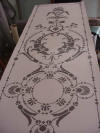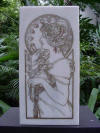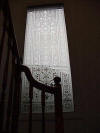WORKING WITH PLOTTERSAuthor: Rick Martin Posted: Revised: August 03, 2005
Rick is looking for plotter sources (suppliers), sources for cheaper software, and I'm sure would be grateful for any comments, suggestions you have. Please E mail me at jim@graydog.org
Jim INTRODUCTIONLike many who take up sandblasting I began by using the “hand-cut” method to produce vinyl resists to transfer my art to glass, and of course there are many who still enthusiastically use this method, producing original “one off” art. In practiced hands it can surpass other cutting methods in speed, freedom of style and randomly added overlay of detail. I used 360º swivel knives, double blades, and weighted surgical knives, and was proud of my line accuracy...cutting many large detailed landscapes…my eyesight was good in those days! But then..... the client turns up who wants several repeats of a very complex design and one flounders at the prospect of hand cutting so many resists…..do you turn them away? PLOTTERSAlthough a plotter cutter is by no means an essential investment when starting out sandblasting, it can eventually become an excellent proposition for anyone who finds themselves to be seriously sandblasting for a living. For the home glass-décor Artist and ornamentalist working on larger scale projects it could even be considered an essential tool. In fact I’m sure many will agree that the time spent actually sandblasting is often far less than the time taken on art work preparation and application processes. Roland Camm Pro 1 CM300 with 73cms cutting width Closeup of Blade Mechanism WHAT IS A PLOTTER CUTTER?Basically a “plotter cutter” or “vinyl sign cutter” is a computer controlled electronic, robotic device capable of accurately cutting, “one off”, or repetitive outlines of art designs (or text) to be used as masks or stencil resists for sandblast projects. Plotters can cut a variety of commercially available materials including, many different types of vinyls, rubber masks for stone and deep stage blasting, specialized screen printing materials for color printing or acid etching, felt cloth materials, some reflective materials used in the sign trade and for Pen plots on paper, very useful for line checks or stock design reference sheets. When they are pushed to their limits and used to their full artistic potential, they are pixel perfect in their accuracy of line, cutting resists of a few inches square to fully designed vinyls meters long. Medium sized mask ready to lay on glass. Close up on stone art nouveau (plotter cut) very complex but infinitely re-sizeable! took 30+ continual hours to vectorize TYPES OF PLOTTERSThere are many models & makes of plotter available supporting various widths of material, prices vary according to make & size but generally speaking some are quite reasonably priced , there is also a thriving second hand market availability. (see makes below). New Roland models are basically good and reliable, though not necessarily the best. Maximum cutting width and reliability are both important factors to consider. Pinch Roller fed plotters are now accurate, to at least 20ft of length cut. Earlier models were Sprocket fed for accuracy in length, these plotters are used less nowadays due to “off-cut” waste and set up time. “Weeding out” stencil masks is not necessarily a chore, it's generally easy and relaxing, though complex, small designs are best weeded on the glass for better adhesion of smaller areas. Accuracy is total, double and triple application masks for glue chipping and stage carving are easily produced, re-sizes, overlays, rubber masks for heavier sandcarving projects on stone etc,.....and more. Plotter makes include: Allen Datagraph Anagraph Aristo Encad NovaCut Gerber Odyssey Graphtec GRC HP Ioline Lynx Mimaki Mutoh New Star Roland SummaCut Zund
PLOTTER Vs PHOTO RESISTS |
|
©2005 Graydog Services • webmaster: jim(at)graydog(dot)org |







